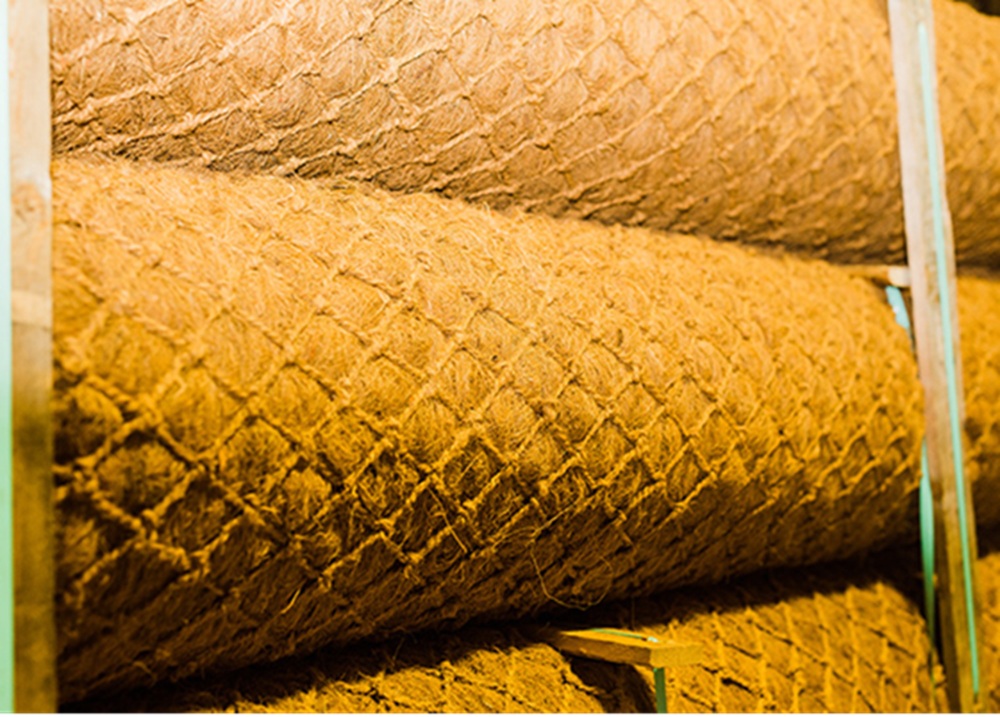Coir logs, also known as coir wattles or Coco Logs, are sediment control products made from all-natural, 100% organic coconut fiber. The word refers to fibers from the outer layer of the coconut fruit in Vietnam.
What Are Coir Logs and Coir Wattles?
Coir logs, also known as coir wattles, are sediment control products made from all-natural, 100% organic coconut fiber. The word refers to fibers from the outer layer of the coconut fruit.
The FASMPO coir logs as sediment retention fiber rolls . These rolls consist of a dense filler material enclosed in a flexible container like coir twine. They are useful in various sediment and flow control applications for maintaining soil integrity.4

Coir Log Applications
Coir logs allow for the restoration of eroded ponds, lakeshores, stream banks and coastal areas. Companies can use them to shore up these areas, halt erosion, prevent habitat destruction and return the environment to its original condition. Natural coir logs prevent soil from moving until natural vegetation can reestablish itself, and they may remain in place alongside a new root system for extra protection.
Coir wattles are particularly useful in applications like the following:
- Creation of check dams in swales and waterways
- Perimeter control
- Inlet protection
- Slope interception
- Sediment trapping
- Water filtration
- Energy dissipation of low-energy waves
Coir Log Benefits
Coir logs offer superior benefits in sediment retention, soil stabilization and vegetative establishment. Below are some of those unique benefits:
- Eco-friendliness: Natural coir wattles are incredibly environmentally friendly. They contain no synthetic netting or chemical additives, so they are easy on the environment. They will not leach toxic substances into the soil or water, and they will not leave behind harmful materials if they degrade. Coir wattles also provide an ideal setting for plant reestablishment in the natural environment.
- Rot and mildew resistance: Coir logs are highly resistant to rot and mildew. This property makes them well suited for aquatic environments. Companies often use coir wattles to prevent erosion in wetland areas, shore up eroded stream banks and protect water structure boundaries, levees and stormwater systems.
- Cost: Coir log costs are generally relatively low. Businesses looking for an economical solution can turn to coir logs for reliable solutions that fit their budgets.
- Reliability: Coir wattles hold up well even under some of the most demanding conditions. These products can absorb up to four times their weight in water without degrading. Under most conditions, they have a functional longevity of up to three years.
- Ease of transport: Unlike concrete or riprap alternatives, coir logs are easy to move from place to place. Companies can use them to ensure soil integrity while saving employees time and promoting on-site efficiency.
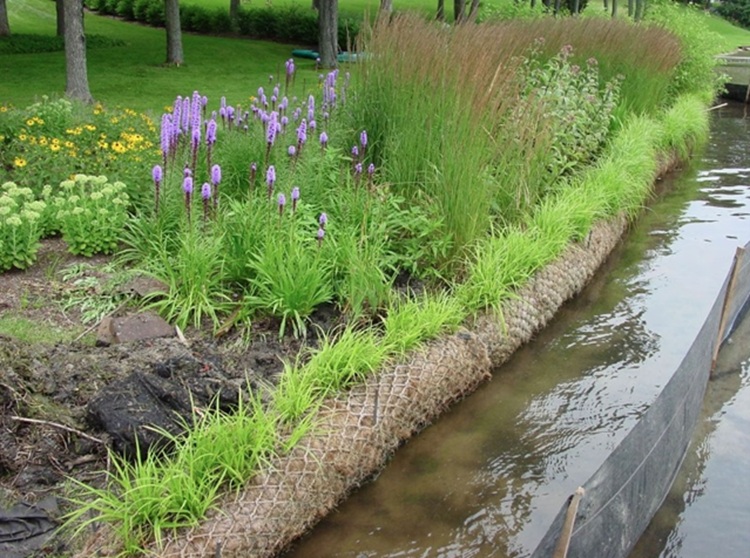
Coir logs and Environmental impact
Many of FASMPO’s new construction projects are striving to achieve the rating and have developed a Green Building System to promote sustainable design and development.
How to use Natural Coir Logs to help your project comply with sustainability in areas such as
- Materials and resources
- Regional priorities
- Sustainable sites
- Water efficiency
Using Coir Log from FASMPO allows companies to maintain sustainable sites by using environmentally friendly, biodegradable materials and resources. Coir Log combined with coir netting or coir mats provide erosion protection, encourage vegetation formation and keep the surrounding environment free of toxic materials.
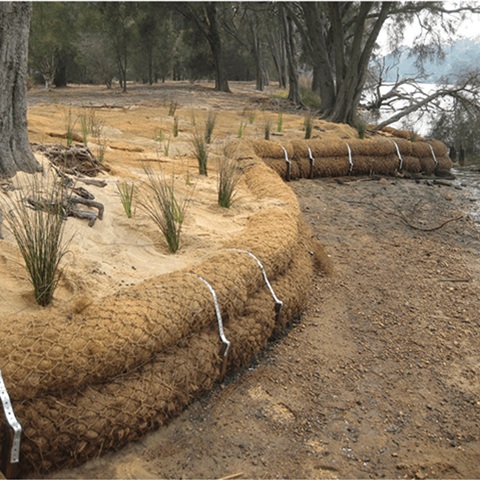
Coir Log Specifications
We have coconut coir logs for sale in a range of sizes, so you can choose the logs that best meet your project’s soil stabilization or sediment retention needs. They come in several standard diameters:
- 12inch Standard Coir Log: We manufacture 12inch standard coir logs with organic fiber and coir twine. This product is a lighter option, best suited for small streams and ponds.
- 16inch Standard Coir Log: The 16inch standard coir log is a little bit larger in diameter than the 12inch product. Its size and organic composition make it durable yet eco-friendly.
- 20inch Standard Coir Log: Our 20inch standard coir logs function best near larger ponds and streams, where more protection is necessary than the 12inch or 16inch coir log can provide.
- 12inch Premium Coir Log: If you’re looking for a strong, dense erosion control solution, consider our 12inch premium coir logs. These are 100% coir and optimal for small lakes or other bodies of water.
- 16inch Premium Coir Log: Our 16inch premium coir logs are made of densely packed organic material. They manage soil and sediment erosion for large or high-energy bodies of water.
- 20inch Premium Coir Log: This coir log option is built for major lake, Bayshore and streambank applications due to its high-density and large diameter.
They are available in standard lengths of 12 or 20 feet. We can also supply custom lengths upon request.
FASMPO’s coir logs also come in two different densities. Our standard coir logs provide 7 pounds per foot, and our premium coir logs offer 9 pounds per foot. Engineers, distributors and construction personnel can choose the densities they’d like to keep in stock for different applications.
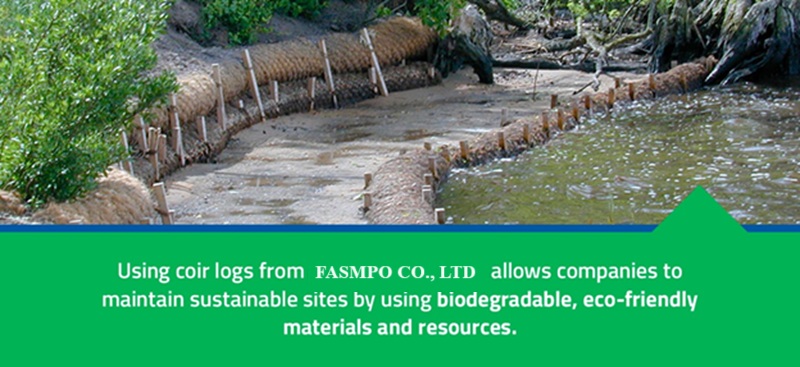
Coir Log Testing
One of the great benefits of using coir wattles on construction and restoration sites is the hydraulic performance testing these products have undergone. The hydrology laboratory at TDT University, Ho Chi Minh Citi, Vietnam, for instance, has performed rigorous testing on different types of sediment control wattles to determine how effectively they perform.
For this evaluation, the lab set up a test flume: a steel-and-glass channel filled with water and capable of adjusting in slope between 0% and 5%. They then installed sediment control logs in a particular section of the basin and monitored their effectiveness in channelized flow tests.
These channelized flow tests consisted of different trials that sent clean water through the channel at various flow rates and slopes across different types of logs. Researchers then measured water depths at specific points both upstream and downstream of the wattles to determine which wattles performed best at reducing supercritical flows — that is, the flow of water downstream from the wattle sites.
In these tests, coconut coir logs demonstrated superior performance to that of similar logs made from materials like excelsior and wheat straw. They were on par with the performance of wood chips and synthetic fibers. The height of their supercritical flows differed by only about 16% from the height measured with immovable weir control.
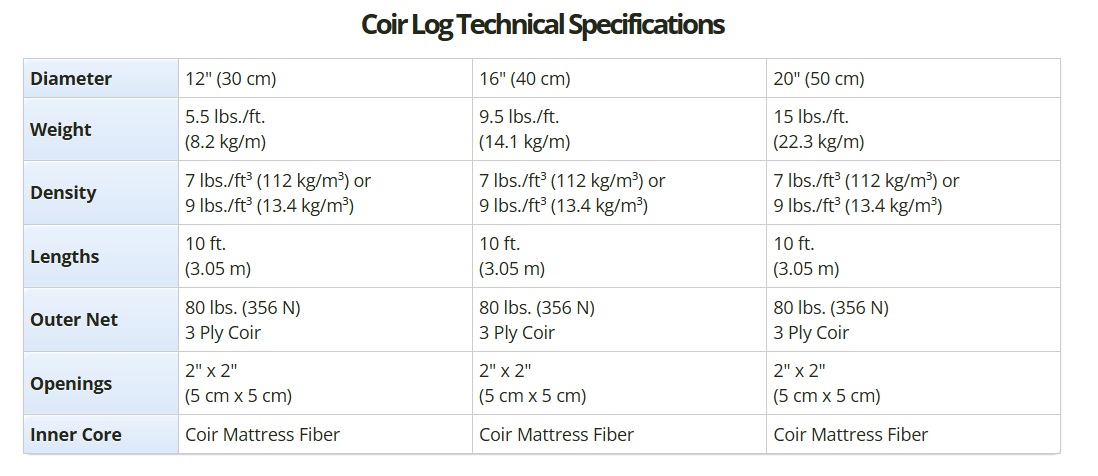 Have you ever wondered what is the correct way to install coir logs?
Have you ever wondered what is the correct way to install coir logs?
Coir logs have a number of applications they are well suited for but are often installed incorrectly resulting in a failure of some type.
The most common applications are:
- Check structures in easements or waterways by Coir log
- Most commonly in batter erosion control by Coir log
Often we see the logs looking very pretty on the surface, on top of the topsoil or even on top of the blown mulch. While this is visually appealing, in most cases the logs themselves are doing very little to protect the topsoil from being washed away in rain events.
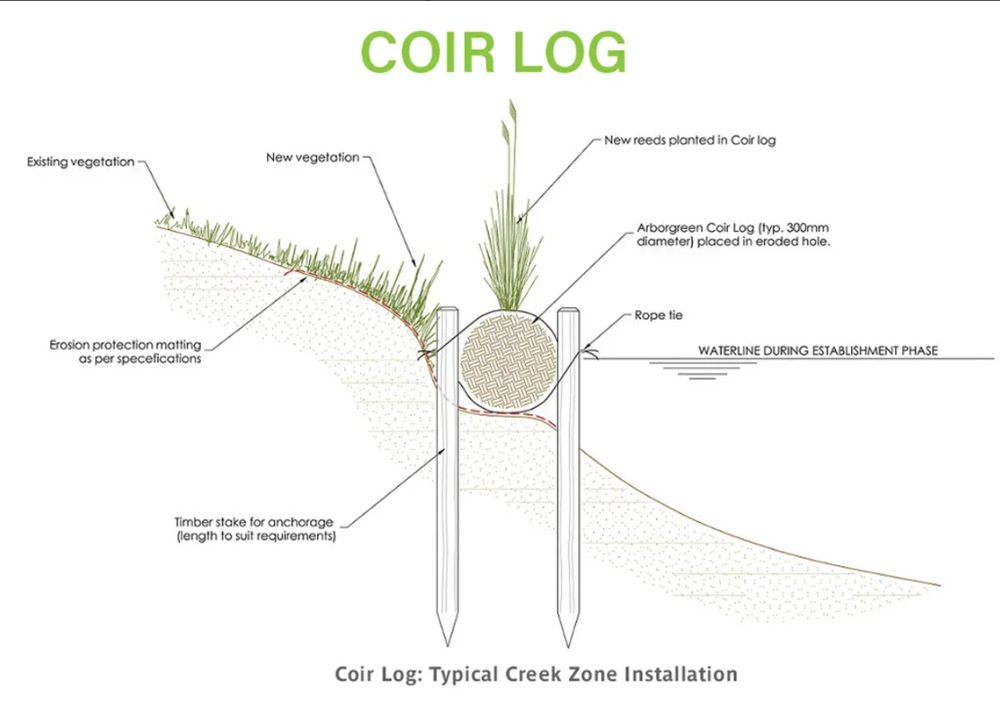
- Check Structures in Easements or Waterways by Coir log
When installing coir logs in easements or waterways the primary function of the log is to slow the flow of water in the drain. This reduces the risk of water lifting the topsoil and carrying it along.
When coir logs are used in this application, we need the water to do one of the following; (i)
- Way 1: pass through the coir log.
- Way 2: pass over the coir log. The coir logs should be installed in such a way that the water does not pass below the log as this will begin to erode the soil.
Installation in Easements or waterways
For seeded drains:
- Ensure your surface is trimmed to site specifications, is smooth and free from obstructions.
- Coir logs are to be installed before hydro mulching, to ensure that at least 1/3 of the coir log is below the top surface level.
- Install logs across the drain, spaced 5m-15m apart depending on the potential water flow velocity.
- Always peg the coir logs on the lower side of the log, making sure the peg goes through the outer mesh of the log.
- Use 450mm x 50mm x 25mm timber pegs for 200mm coir logs, or 600mm x 50mm x 25mm timber pegs for 300mm coir logs. The pegs should be driven an equivalent length into the ground as what is above ground.
- Hydromulch the drain once the logs are all installed.
For turfed drains:
- Ensure your surface is trimmed to site specifications, is smooth and free from obstructions.
- Coir logs are to be installed on top of the topsoil prior to turfing.
- Install logs across the drain, spaced 5m-15m apart depending on the potential water flow velocity.
- Always peg the coir logs on the lower side of the log, making sure the peg goes through the outer mesh of the log.
- Use 450mm x 50mm x 25mm timber pegs for 200mm coir logs, or 600mm x 50mm x 25mm timber pegs for 300mm coir logs. The pegs should be driven an equivalent length into the ground as what is above ground.
- Once logs are installed, lay the turf up to the logs as per image 1below.
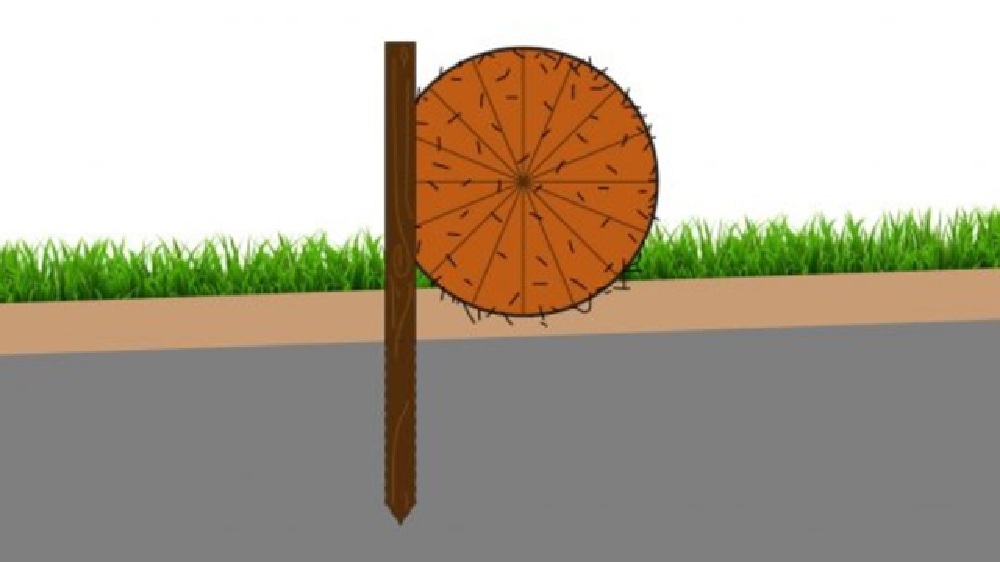
- Topsoil Containment Structures (Batter Erosion Control) by Coir log
This is by far the most common application for coir logs, and unfortunately where we see the most install errors. In this application, the coir log is often only a visual product and not used to effectively reinforce the soil on which it is placed.
The purpose of the coir log in this application is to reduce the risk of the topsoil, mulch and plants being washed out in a large rain event.
Installation in Batters, Slopes and Embankments
Coir logs are best installed directly onto the profiled slope prior to any topsoil, mulch or planting being done. This ensures they will sit in rather than on the topsoil, preventing it from being washed out from underneath the log.
- Ensure batter is profiled to the required gradient, is smooth and free from obstructions.
- For topsoil of up to 150mm, use 200mm coir logs. For topsoil deeper up to 250mm, use 300mm coir logs.
- Install the coir logs across the face of the slope, starting from the lowest row and working up. Ensure the logs are butted right up to the one next in line. Better still, if they could be overlapped by 150mm (see figure 3 below) this will ensure soil will not be washed between the logs.
- Peg the coir logs to the batter, using 450mm x 50mm x 25mm timber pegs for 200mm coir logs, or 600mm x 50mm x 25mm timber pegs for 300mm coir logs. The pegs should be driven an equivalent length into the ground as what is above ground.
- Always drive the pegs through the coir log, not in the centre of the log, but towards the lower edge of the log to ensure a greater part of the log is taking the load of soil reinforcement. (pegs should not be driven either side of the log, as in high rainfall events the logs can be lifted over the pegs)
- Use a minimum of 3 pegs per log, 1 on each edge and 1 in the centre for slopes up to 3:1. For steeper gradients than this, use minimum of 4 pegs.
- Once the bottom row of logs is complete, install the next row 2.5m above bottom row for batters at less than 3:1. For batters of up to 2:1, work on 2m spacing between rows, and 1:1 gradient will need maximum spacing of 1.5m. (for 1:1 batters, it is recommended you speak to a qualified engineer to determine the best method of stabilisation for your application)
- Once coir logs have been pegged in properly, you can proceed to backfill the topsoil in behind the rows of logs.
- Once the topsoil and mulch has been applied, the coir logs should be almost buried.
- For embankments that have been hydro mulched, it is recommended to use a coir mesh blanket to protect against wind erosion. The coir mesh can be installed vertically down the slope over the top of the coir logs and pinned at regular intervals.
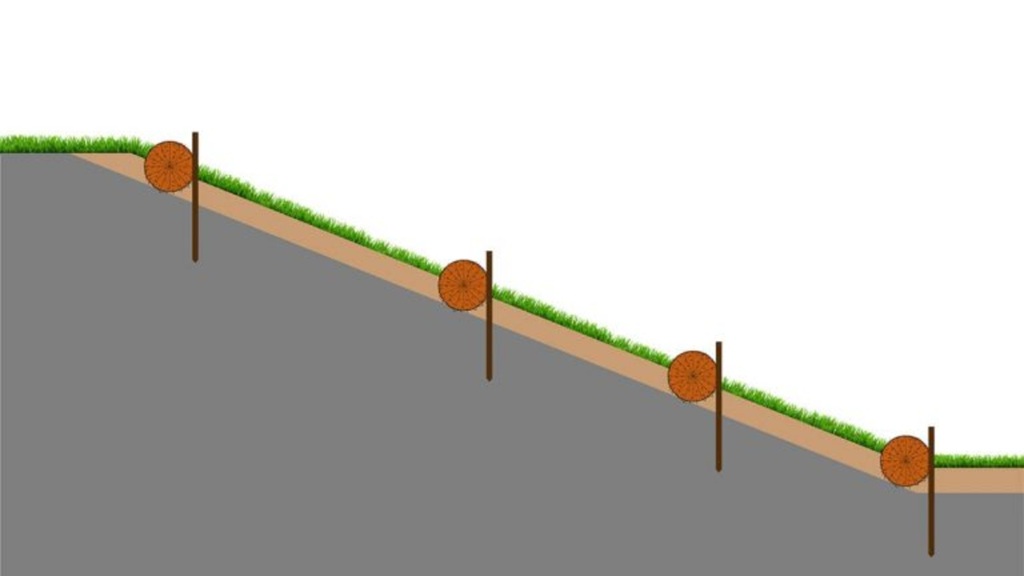
Why do I use a temporary erosion control blanket as well as coir logs? Very valid question!
The Coir Log is a retaining structure designed to protect against water erosion. The COIR MAT are designed to control wind erosion. They also hold moisture ensuring optimum soil conditions for tube stock or seed growth.
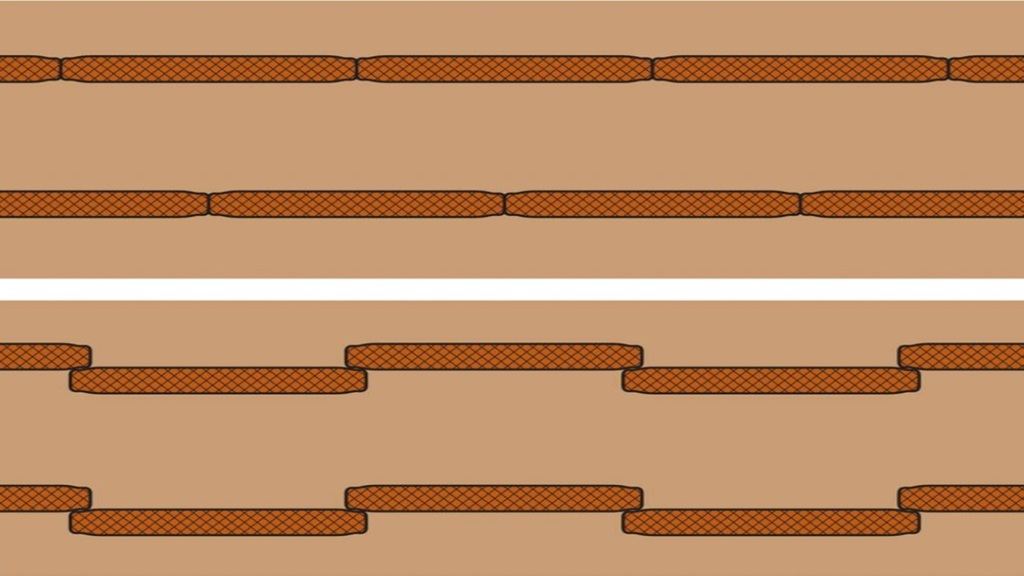
Coir Logs price in Vietnam from 01/01/2025
Coir Logs price in Vietnam can fluctuate depending on many factors such as size, quality and supplier. Coir poles are made from 100% natural coconut fiber, are biodegradable and are commonly used for erosion control and soil stabilization.
EXW price 12 inch Coir log : 8.26 -16.54 $/piece
EXW price 16 inch Coir log: 12.40 -24.01 $/piece
EXW price 20 inch Coir log: 15.75 -27.56 $/piece
Contact us:
- Our Factory : Click here
- Factory's products: Click here
- Free Sample : Click Here
- Video's product: Click here
FASMPO – the leading exporter in the Vietnamese market
